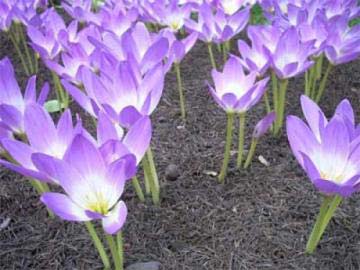| Annual / Summer and winter bulbs / Saffron Bulbs - wonderful crocus flowers to get best spice |
|
|
|
|
| |
|
Plant name - Crocus saffron (Greek variety) |

|
|
 |
|
 |
| Common name - saffron
|
| Plant type - Flowers |
| Vegetation type -
Annual |
| Growth rate - fast |
| Leaf / Flower color
- Green / pink - purple |
| Other names - Azafran - crocus sativus spanish |
| |
| Description : |
The gold of Greek land! The best quality saffron in the world!
Discrimination and those classifications has, according to surveys, studies, etc., distract the saffron grown in many, small villages of the prefecture of Kozani.
The cultivation of this, traditional product in the prefecture of Kozani Saffron and surrounding villages dates back to the 17th century.
crocus like plant , dye, medicine , herb or condiment was known both in ancient Greece and other ancient peoples .
In fact was one of his most beloved plants of the ancient Greeks, Egyptians and Romans for various reasons. Including but not limited to : the aroma , color and aphrodisiac properties.
So it should cause why Cleopatra used it in cosmetics , the ancient Phoenicians in their bids to the goddess Astarte , etc.
|
| |
| Growing Instructions : |
* Saffron is a very expensive spice you can cultivate at home by growing your own crocus bulbs. Saffron spice is made from the stigmas of saffron flowers.
* Plant bulbs in well drained, partially sandy or gritty soil in a location that receives full sun or several hours of sun per day. The preferred planting depth is 3 to 4 inches. Saffron bulbs need a climate that is hot and dry in the summer and cold in the winter for best results. They are hardy in temperatures as low as minus 15 .
* Plant a cover flower such as creeping phlox over the saffron bulbs for additional bloom time for that area of your flowerbed. Saffron have no difficulty sending shoots up through low spreading plants, and the extra cover will also keep your sprouts
* Divide saffron bulbs every two years to prevent overcrowding. Carefully dig up bulbs during the dormant summer months and replant about six inches apart to allow for the growth of new bulbs. The upside and downside of bulbs may be difficult to identify when they are dry or dormant with no stem. Usually the bottom of the bulb is flat and the top side will be showing the tips of shoots. The roots will grow in the right direction even if they are planted upside down.
* Plant bulbs in the early fall for blooms and harvest in the fall of the following year. Saffron bulbs will grow grassy looking clumps of shoots soon after planting, and will develop strong roots over the winter. Shoots grow up to 24 inches tall in the winter before summer dormancy, producing new leaves and first flowers the following fall.
|
| |
|
|
|
|
|
